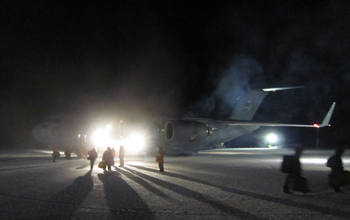Winter-fly-in 2010 ushers in the 2010-2011 antarctic field season
August 20, 2010
In the dark
First USAP flight since March lands in Antarctica during winter night
The first U.S. Antarctic Program flight to Antarctica landed safely at Pegasus airfield near McMurdo Station on August 15, 2010, ushering in the 2010 Winfly season. Winfly is the time between winter and the summer when additional support personnel, such as carpenters and cooks, arrive to prepare the station for the upcoming science field season. Several groups of scientists are also scheduled to arrive during Winfly to take advantage of the atmospheric conditions at that time of year, as well as to study the foraging behavior of seals under dark conditions. The flight was particularly noteworthy for the use of night-vision goggles, which help the C-17 pilots land on the ice runway in the dark in conjunction with reflective runway markers. The Air Force first tested the capability in 2008, but this is the first year passengers flew on a night-vision mission. About 120 people were aboard the plane. Seven flights are planned for the month of August before the main summer field season begins in late September.
By Peter Rejcek, Editor, Antarctic Sun, USAP.gov
To read more about the use of night-vision goggles and Winfly, see related the story "Ramping up" published on the Antarctic Sun web site at http://antarcticsun.usap.gov/
The U.S. National Science Foundation propels the nation forward by advancing fundamental research in all fields of science and engineering. NSF supports research and people by providing facilities, instruments and funding to support their ingenuity and sustain the U.S. as a global leader in research and innovation. With a fiscal year 2023 budget of $9.5 billion, NSF funds reach all 50 states through grants to nearly 2,000 colleges, universities and institutions. Each year, NSF receives more than 40,000 competitive proposals and makes about 11,000 new awards. Those awards include support for cooperative research with industry, Arctic and Antarctic research and operations, and U.S. participation in international scientific efforts.
Connect with us online
NSF website: nsf.gov
NSF News: nsf.gov/news
For News Media: nsf.gov/news/newsroom
Statistics: nsf.gov/statistics/
Awards database: nsf.gov/awardsearch/
Follow us on social
Twitter: twitter.com/NSF
Facebook: facebook.com/US.NSF
Instagram: instagram.com/nsfgov



